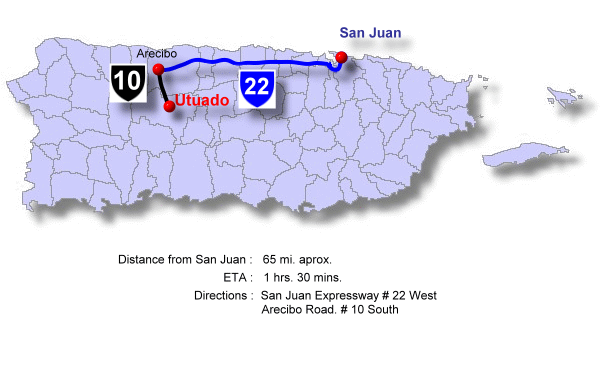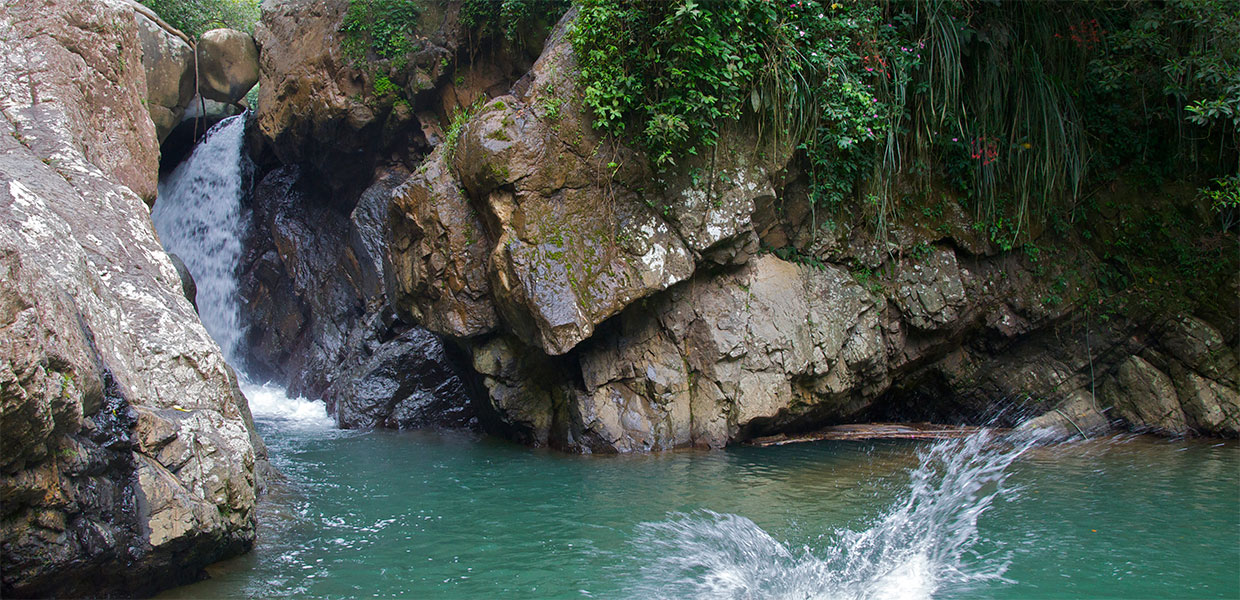
Utuado, Puerto Rico
City of the Viví
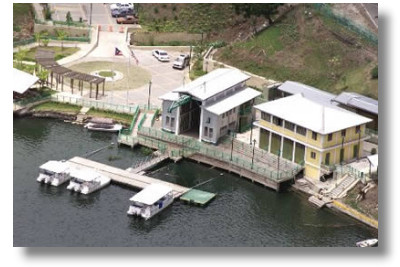 Utuado (oo-too-AH-do) is known as the “City of the Viví” and the town of “The Highlanders”. The municipality’s patron saint festival is held in late September in honor of San Miguel Arcángel. Other cultural festivals include the Otoao festival in December and the Angeles neighborhood festival in March.
Utuado (oo-too-AH-do) is known as the “City of the Viví” and the town of “The Highlanders”. The municipality’s patron saint festival is held in late September in honor of San Miguel Arcángel. Other cultural festivals include the Otoao festival in December and the Angeles neighborhood festival in March.
Utuado is located in the mountainous central part of the island. It is bordered to the north by the municipalities of Hatillo and Arecibo, to the south by Adjuntas, Ponce and Jayuya, to the east by Ciales and Jayuya and to the west by Lares. Geographically, it is part of the central mountainous interior and its highest elevations are found in the southern part of the municipality, which is part of the central mountain range.
Utuado is the site of the Caguana Indigenous Ceremonial Park, one of the most important Taino sites in Puerto Rico. It is estimated that this ceremonial center is more than 700 years old. The complex includes a large ceremonial plaza surrounded by petroglyphs. Sport fishing is also available in Utuado’s Caonillas and Dos Bocas lakes, which have abundant catfish, sunfish and bass.
Utuado’s economy is mainly based on agriculture. Coffee and other fruits are grown. The municipality also has factories producing textiles and paper.
Foundation:
Before the discovery of the Island, Utuado, had been populated by diverse indigenous cultures. The main groups were: the archaic, igneris, sub-taínos and finally during twelvth century, the Taínos. Utuado’s name derives from Cacique (Chief) Otoao which means “between mountains”.
In 1512, several landowners had settled there, among them Blas de Villasante and Antonio Cedeño. Both wanted to found a town on their estates, but the governor did not accept. Several centuries passed before another attempt to found a town began.
In 1733, a group of families from Arecibo delegated Don Sebastián de Morfi to request of governor Matías de Abadía the founding of a town according to the laws of the Indies. For such purposes the estates of the Ranch of Utuado, owened by Don Manuel Natal were appraised. In October of 1734 the Ranch of Utuado was sold to the settlers for 569 pesos and 5 reales for the foundation of the new town.
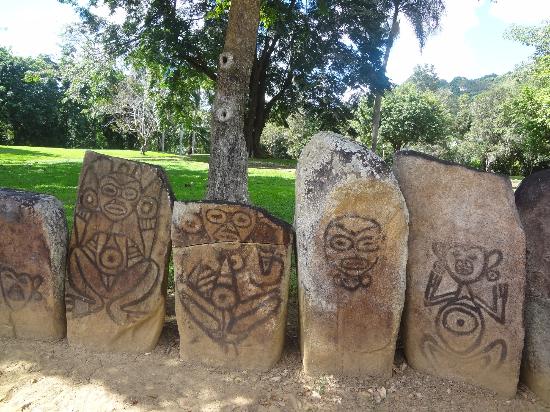
On November, 1734, governor Matías de Abadía granted permission to initiate the foundation of Utuado. Nevertheless, it was not until October 12, 1739, that sixty families found the Villa del Otoao. These families came from Arecibo, San Germán, Ponce and Aguada. Of the total of 117 people, only two were foreign (2 Irish and 2 Andalusians).
The construction of Utuado’s church was finished July 15, 1743, dedicated to its patron San Miguel Arcángel. It was built in wood with a straw roof. In August, 1746, the church was constituted as an independent parish.
Utuado’s population and economy continue growing during the rest of the eighteenth century and all of nineteenth century. By 1769, there were at least 110 farms registered, dedicated to cattle and agriculture.
The contraband activity with the English, Dutch and French was very popular in that era, defying the serious penalties imposed by the Spanish government. It was perhaps the only way to obtain tools and other goods since these articles did not enter Puerto Rico or were of bad quality.
During the nineteenth century, the economic activity was centered around the “black gold” boom, coffee. Between 1864 and 1885, 68 coffee plantations were established. This economic growth induces a rich social life, the opening of a casino and a theater in the town.
On the day of the abolition of slavery in 1873, 167 slaves were given their liberty.
The town progressed so much in agriculture and commerce that on August 20, 1894, the regent Queen María Cristina granted the town of Utuado the title of City.
During 1895, Utuado was the second city in Puerto Rico with a electrical plant and its mayor Juan Casellas in 1897 planned the union of Utuado with Arecibo by train.
At the end of the century, two events finished with this golden era: the San Ciriaco hurricane of 1899 and the change of sovereignty in 1898. The new king now was, “sugar cane”, for which Utuado’s topography was not ideal. During the decade of the 1990, the coffee industry revived making Utuado the second coffee producer in Puerto Rico with 1,600 tons produced in 1,143 farms.
One of the most tragic episodes in the history of Utuado and Puerto Rico was without a doubt the Massacre of Utuado during the 1950 Nationalistic Revolt. On October 30, in Arecibo, Peñuelas, Naranjito, Mayagüez, Ponce, Jayuya, Utuado and Washington DC, the Nationalistic Revolt exploded simultaneously.
The orders of Pedro Albizu Campos were to resist in each one of the respective towns and then to retreat to Utuado. Once here, to continue resisting at least a month to attract the attention of the UN and to force the intervention of the Security Council. All the nationalistic groups were neutralized in their respective towns. The group from Utuado was originally made up of 32 people, their leaders were Heriberto Castro and Damián Torres. After being repelled by the police, the group was reduced to twelve people who entrenched themselves in Damián Torres’ house. During the shooting, Heriberto Castro died. Due to their obstinate resistance, the house was machine-gunned by four Thunderbolt airplanes using 50 caliber machine guns. The police were reinforced by the National Guard, who arrived around seven pm. At midnight, their surrender was demanded. Minutes later the rebel group, now of nine people, surrenders. From here they were taken through Dr. Cueto Street up to the Recreation Plaza where they were striped of their shoes, belts and pockets. Soon after, the group was taken to the Police Station, where they were executed by machine-gun fire. Four people died and five were severely wounded. A survivor, 17 year old Antonio González, was finished off with a bayonet. The Nationalistic Revolt in all the island ended with a toll of 29 dead people and 47 wounded.
Location:
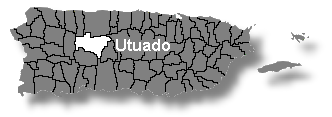 Located in the mountainous region of the island, it is bordered by: Hatillo and Arecibo on the north; Adjuntas, Ponce and Jayuya on the north; Lares on the west; and Ciales and Jayuya on the east.
Located in the mountainous region of the island, it is bordered by: Hatillo and Arecibo on the north; Adjuntas, Ponce and Jayuya on the north; Lares on the west; and Ciales and Jayuya on the east.
Area:
299.0 sq km / 115.0 sq mi
Population:
35,336 (census 2000)
Population Density:
118.1 per sq km / 307.2 per sq mi
People are known as:
Utuadeños
Utuado is also known as:
Ciudad del Viví (City of the Viví)
Los Montañeses (The Mountaineers)
Wards: Utuado, Puerto Rico
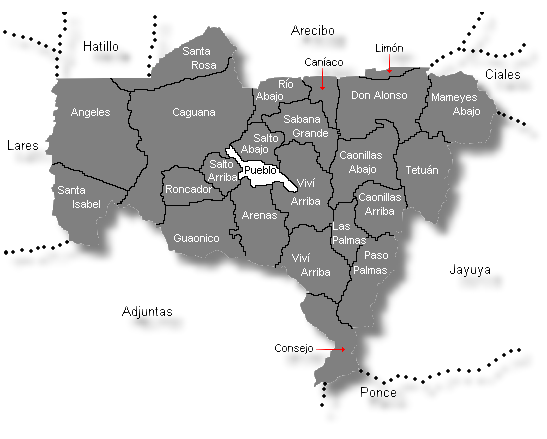
| Census 2000: Population by Wards – Utuado |
Habitants |
| Ángeles | 3,457 |
| Arenas | 2,295 |
| Caguana | 4,247 |
| Caníaco | 155 |
| Caonillas Abajo | 1,234 |
| Caonillas Arriba | 395 |
| Consejo | 538 |
| Don Alonso | 897 |
| Guaonico | 654 |
| Las Palmas | 1,235 |
| Limón | 223 |
| Mameyes Abajo | 1,207 |
| Paso Palma | 556 |
| Río Abajo | 325 |
| Roncador | 579 |
| Sabana Grande | 985 |
| Salto Abajo | 5,724 |
| Salto Arriba | 442 |
| Santa Isabel | 682 |
| Santa Rosa | 0 |
| Tetuán | 756 |
| Utuado Town | 5,363 |
| Viví Abajo | 2,817 |
| Viví Arriba | 570 |
| Total | 35,336 |
Información: Negociado del Censo de los EE.UU. Censo 2000
Patrón:
San Miguel Arcángel
San Miguel Arcángel Parish
P.O. Box 10
Utuado, P.R. 00641-0010
(787) 894-2696
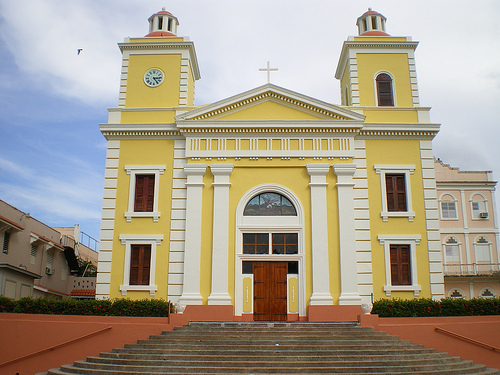
Topography:
It is located in the Central Interior Mountain region. Its greatest elevations are to the south where the Central Mountain Range is situated.
Hydrography:
It is watered by the following rivers: Grande de Arecibo; el Guaónico; Roncador; Viví; Caguana; Caguanita; Caonillas; Grande de Jayuya; Jauca; Limón; Naranjito; Palmarejo; La Venta; Yunes; Tanamá; Caonillas and Limón rivers. It also has the following four dams: Caonillas, Dos Bocas, Jordán and Viví.
Economy:
Agriculture; coffee, tobacco and fruits.
Average Salary:
$263.16 weekly (1998)
Flag:
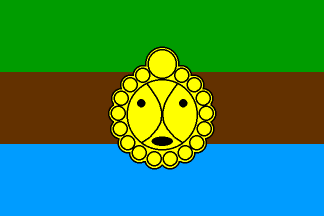 On January 5, 1987, the Municipal Assembly of Utuado adopted the official flag of Utuado. The superior green stripe symbolizes the green mountains; the brown stripe (in the middle) symbolizes the rich land of Utuado, and the bottom clear blue stripe is symbol of the rivers and lakes of our land. The Sun of Otoao in the center is a copy of one of most important of our indigenous culture because it is a symbol of the Taíno culture. Designed by Luis A. Lafontaine.
On January 5, 1987, the Municipal Assembly of Utuado adopted the official flag of Utuado. The superior green stripe symbolizes the green mountains; the brown stripe (in the middle) symbolizes the rich land of Utuado, and the bottom clear blue stripe is symbol of the rivers and lakes of our land. The Sun of Otoao in the center is a copy of one of most important of our indigenous culture because it is a symbol of the Taíno culture. Designed by Luis A. Lafontaine.
Coat Of Arms:
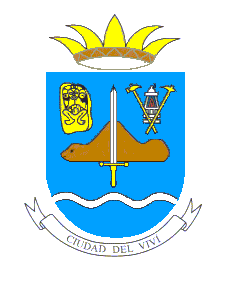 The design of the Coat of Arms of Utuado was made by Dr. J.J. Santa Pinter de Arga and adopted in 1981 approved by the Decree Number 24 of the 1980-1981 series. Its heraldic description is the following one:
The design of the Coat of Arms of Utuado was made by Dr. J.J. Santa Pinter de Arga and adopted in 1981 approved by the Decree Number 24 of the 1980-1981 series. Its heraldic description is the following one:
- In a blue field the figure of the Cemí in its original color with a silver sword, gold grip.
- In the head to right the figure of the Woman of Caguana, of gold, and to left a stick with a pick in gold with a silver lamp with red flame.
- In the base, an undulated stripe in silver.
- At the top a five point crown in gold, surrounded with a brown stripe and covered in silver.
- The banner’s inscription “City Of The VIVI”.
The symbolic meaning is the following one:
- The main figure of the Coat of Arms is a Cemí crossed by a sword. The color of the Cemí is brown, imitating the color of the earth. The silver sword with gold grip invokes San Miguel Arcángel, Patron Saint of Utuado. The Cemí indicates the rich pre-Columbian historical tradition. The combination of the symbols stands for the unity and continuity of the pagan past of the Taíno and the Christian present of Utuado.
- The mythological indigenous figure represents the Woman of Caguana, symbol of fertility for the Taínos.
- The symbols of the mines, the gold pick and shovel crossed with the traditional lamp of the silver miners, with the red flame, refer to the mineral wealth of the zone and the mining operations of the past.
- The color of the field is blue for the blue skies of the town contrasting with the green of the landscape.
- The waving silver stripe invokes the Vivi River, of which Utuado takes its name from “City of Vivi”.
- For the top an Indian crown brown. With it the traditional value of Utuado in pre-Columbian history is indicated. This symbol distinguishes Utuado from the remaining municipalities of the island.
Places To Visit:
- Caguana Indigenous Ceremonial Park
- El Saltillo Falls
- Dos Bocas Lake
- Ivanet Gallery
- Roses Estate
- Monument to Utuado Soldiers
- Dos Bocas Dam
- Río Abajo Forest Preserve
- Hacienda Taína Workshop
Events:
- Otoao Cultural Festival – December
- Angeles Neighborhood Festival – March
- Tierra Adentro Festival – April
- Guarionex Festival – April
- Rosary of the Cross – May
- Patron Saint Festival – September
Distinguished Citizens:
- María Libertad Gómez – Educator and politician. She was one of the founders of the Popular Democratic Party and was vice president of the House of Representatives, over which she presided for a brief time in 1945. She also served as a delegate to the Constituent Convention of the Commonwealth of Puerto Rico. She founded the first tobacco cooperative on the island.
- Isaac González Martínez – Physician. He was a pioneer in cancer research on the island and discovered the origin of various illnesses.
- Ramón Juliá Marín – Wrote poetry, short stories and novels. His best works are the novels Tierra adentro and La gleba.
- Jesús María Lago – Poet and painter.
Public Schools sorted by educational levels.
Utuado District
| Name | Leve | Telephone | Address |
| ÁNGELES EL CORCHO | Elementary | (787) 894-5337 | PO Box 481 |
| CARMEN APONTE | Elementary | (787) 894-7744 | PO Box 435 |
| EUGENIO J. VIVAS | Elementary | (787) 894-7245 | PO Box 490 |
| FÉLIX SEIJO | Elementary | (787) 894-2600 | 6 Calle Tomás Jordán |
| MARIA LIBERTAD GÓMEZ | Elementary | (787) 894-2188 | Calle12 Suite 206 Centro Gubernamental |
| MONSERRATE MORENO | Elementary | (787) 894-2486 | 174 Ave. Esteves |
| PASO PALMA I | Elementary | (787) 894-0241 | PO Box 602 |
| SABANA GRANDE ABAJO | Elementary | (787) 894-6363 | HC- 2 Box 6318 |
| FRANCISCO RAMOS | Intermediate | (787) 894-2470 | PO Box 950 |
| JOSÉ VIZCARRONDO | Secondary | (787) 894-7702 | PO Box 416 |
| ANTONIO TULLA TORRES | Second Unit | (787) 894-0229 | PO Box 6619 |
| BERNARDO GONZÁLEZ | Second Unit | (787) 894-2524 | PO Box 1447 |
| CELINA MAESTRE | Second Unit | (787) 894-5904 | PO Box 100 |
| FRANCISCO JORDÁN | Second Unit | (787) 894-7705 | PO Box 1095 |
| INOCENCIO MONTERO | Second Unit | (787) 894-1448 | PO Box 159 |
| ISABEL M. RIVERA | Second Unit | (787) 894-2680 | HC 2 BOX 6318 |
| MARTA LAFONTAINE | Second Unit | (787) 894-0000 | PO Box 510 |
| JUDITH VIVAS | High School | (787) 894-3446 | PO Box 81 |
| LUIS MUÑOZ RIVERA | High School | (787) 894-2666 | Suite 206 |
Hymn:
By Amilcar Rivera Díaz
Valle bendito el de mi Otoao,
mundo de verde, de azul y sol,
tierra del pitirre y del guaraguao,
cáliz y altar de mi amor.
Es de mi patria su corazón.
Es fiel guardián de su tradición.
Es el perenne y firme bastión
del alma de mi país.
Utuado, amado Utuado,
¿Como no has de estar en mí
si creció mi alma en tus campos
y mis sueños acunó el Viví?
Si algún día de ti me alejo
o si calla al fin mi voz
dejo como eterna ofrenda a ti
hecho canción mi amor.

